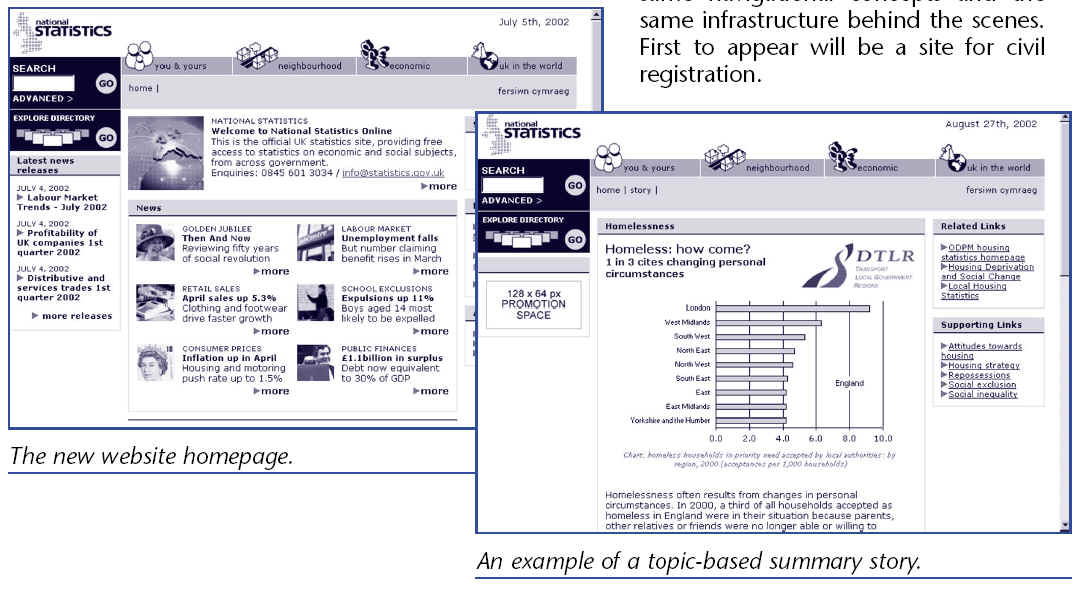New look for National Statistics website�
Are you a �frequent flyer�, an occasional�
dipper or a first time caller at�
www.statistics.gov.uk� ? Whatever. You should
be aware that in September, the appearance
and structure of this gateway to a wide
range of official statistics changed in
response to user-based views of what would
be desirable improvements. The new
website has a new look and offers new ways
of navigating through its content. The
culmination of over six months planning,
research and work, it is only the first stage of
web development plans: the long-term
objective is to present a picture of �the state
of the nation at the click of a button�.�
Hitherto, finding information on the website has been a problem for many users. Extensive customer research has shown consistently that what users want is a clear and uncluttered website, with logical links, and a focus on topical information and new releases. In March 2002 IBM was commissioned to look at the website and the user research, and create a new navigational model for the site so users could easily get to the information they were looking for.�
Following a review, it was concluded that the amount of information online was so comprehensive, and that users were so diverse, that a single �one size fits all� structure for the website could not be built. A better solution would be to create multiple navigational routes through the available information. The solution was to offer three different navigation routes.�
- Navigation by text search. Likely to be the favourite route of those who know exactly what they are looking for. A single search box will query all the databases which support the website; presently, different search boxes in different areas query different permutations of the databases. The search results are categorised, with separate listings for datasets, articles, products, and so on. Brief summaries of each result are also shown, guiding users towards the material they really want. It is planned to extend this search facility to also cover Neighbourhood Statistics (NeSS).�
- Navigation by directory. Aimed at those who know the kind of information they want, but not perhaps the name of a particular product or release. The National Statistics Category List (NSCL) works as a �site map�, allowing users to drill down from general themes to very detailed topics, until they find the particular information they require. This type of hierarchical navigation will be familiar to anyone who has used portal websites such as Yahoo.�
The NSCL is a major improvement on the current StatBase directory. At the moment, a specific topic can only live beneath a single top-level heading. In the NSCL, topics can sit under many different headings simultaneously. For example: if one wanted information on recruits to teacher training, would one look under Labour Market or Education & Training? If StatBase users guessed wrong, they would soon be lost. In the NSCL, the same topic lives under both headings.�
- Navigation by topic-based summary. One feature of the new website is the wider use of short articles written for the nonexpert, often based around the latest releases. Obviously these topic-based summaries only give access to a limited amount of information. However, they can give an overview of the most popular and relevant outputs of the Government Statistical Service, and provide for nonexpert users an idea of the state of Britain. Links are to be provided to any relevant data or metadata, allowing the interested reader to dig deeper.�
The new look website supports the new
ways of navigating through the online
information. Following consultation, a
design was created that was simple to use,
reflected user research, and made the best
use of the new navigational models.
Screenshots from the new site are illustrated
below.�
The collection of topic-based summaries will double in size in the coming months, from around 50 to a notional target figure of 150. It is also planned to extend the reach of the search engine, to cover other organisations� statistical web pages, and to extend the use of the National Statistics Category List.
Work will also begin on a network of �sibling
sites�, spun off from the current National
Statistics website. These will have a slightly
different visual appearance, but will use the
same navigational concepts and the
same infrastructure behind the scenes.
First to appear will be a site for civil
registration.
